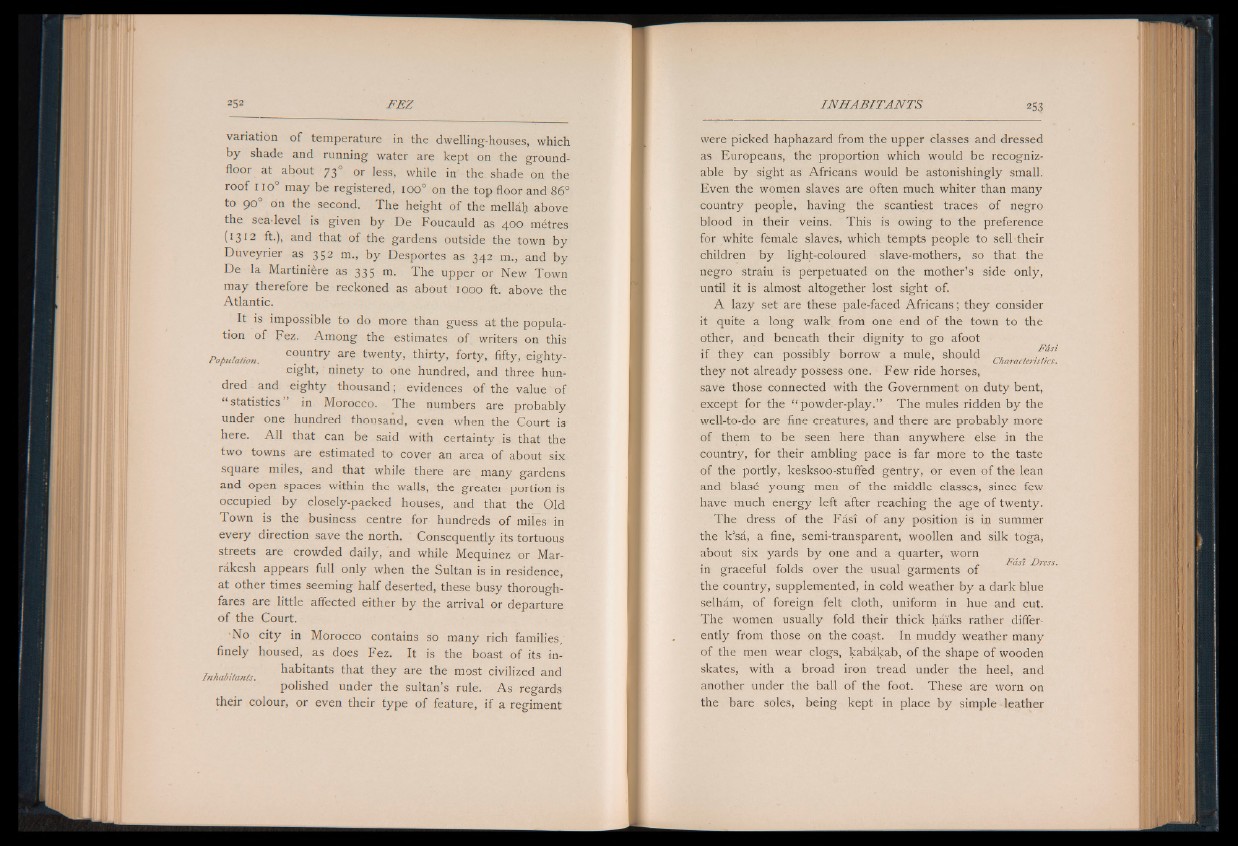
variation of temperature in the dwelling-houses, which
by shade and running water are kept on the ground-
floor at about 730 or less, while in the. shade on the
roof i io ° may be registered, ioo° on the top floor and 86°
to 90° on the second. The height of the mellâh above
the sea-level is given by De Foucauld as 400 métrés
(1312 ft.), and that of the gardens outside the town by
Duveyrier as 352 m., by Desportes as 342 m., and by
De la Martinière as 335 m. The upper or New Town
may therefore be reckoned as about 1000 ft. above the
Atlantic.
It is impossible to do more than guess at the population
of Fez. Among the estimates of writers on this
Population. country are twenty> thirty, forty, fifty, eighty-
e*gbt, ninety to one hundred, and three hundred
and eighty thousand ; evidences of the value ' of
“ statistics” in Morocco. The numbers are probably
under one hundred thousand, even when the Court is
here. A ll that can be said with certainty is that the
two towns are estimated to cover an area o f about six
square miles, and that while there are many gardens
and open spaces within the walls, the greater portion is
occupied by closely-packed houses, and that the Old
Town is the business centre for hundreds of miles in
every direction save the north. Consequently its tortuous
streets are crowded daily, and while Mequinez or Marrakesh
appears full only when the Sultan is in residence,
at other times seeming half deserted, these busy thoroughfares
are little affected either by the arrival or departure
o f the Court.
•No city in Morocco contains so many rich families;
finely housed, as does Fez. It is the boast of its in-
Inhabitants habitants that they are the most civilized and
polished under the sultan’s rule. As regards
their colour, or even their type of feature, if a regiment
were picked haphazard from the upper classes and dressed
as Europeans, the proportion which would be recognizable
by sight as Africans would be astonishingly small.
Even the women slaves are often much whiter than many
country people, having the scantiest traces of negro
blood in their veins. This is owing to the preference
for white female slaves, which tempts people to sell their
children by light-coloured slave-mothers, so that the
negro strain is perpetuated on the mother’s side only,
until it is almost altogether lost sight of.
A lazy set are these pale-faced Africans; they consider
it quite a long walk from one end of the town to the
other, and beneath their dignity to go afoot
if they can possibly borrow^J J ■ a mule, should CharacIte riBstiHcs.
they not already possess one. Few ride horses,
save those connected with the Government on duty bent,
except for the “ powder-play.” The mules ridden by the
well-to-do are fine creatures, and there are probably more
of them to be seen here than anywhere else in the
country, for their ambling pace is far more to the taste
of the portly, kesksoo-stuffed gentry, or even of the lean
and blasé young men of the middle classes, since few
have much energy left after reaching the age of twenty.
The dress of the Fasi of any position is in summer
the k’sa, a fine, semi-transparent, woollen and silk toga,
about six yards by one and a quarter, worn
Fasi Dress.
in graceful folds over the usual garments of
the country, supplemented, in cold weather by a dark blue
selhàm, of foreign felt cloth, uniform in hue and cut.
The women usually fold their thick haiks rather differently
from those on the coast. In muddy weather many
of the men wear clogs, kabàkab, of the shape of wooden
skates, with a broad iron tread under the heel, and
another under the ball of the foot. These are worn on
the bare soles, being kept in place by simple leather